Do you have a question about the Craftsman 315.101150 and is the answer not in the manual?
Guidelines for maintaining a clean, well-lit work area and keeping bystanders away to prevent accidents.
Essential precautions for safe electrical connections, including plug compatibility, grounding, and cord care.
Advice on staying alert, using safety equipment, and avoiding accidental starts for personal protection.
Emphasizes checking for damaged parts, using auxiliary handles, and proper tool operation for safety.
Guidelines for selecting and using extension cords, focusing on wire gauge and condition for safe operation.
Recommends safety glasses, dust masks, hearing protection, and awareness of hazardous materials in dust.
Defines symbols for electrical units (Volts, Amps, Hz), power (Watt), time (min), current types (AC/DC), and speed/construction.
Interprets symbols indicating wet conditions, manual reading, eye protection, general safety alerts, hand proximity, and hot surfaces.
Provides guidance on tool servicing by qualified technicians and stresses the importance of reading and saving the manual.
Describes double insulation as a safety feature eliminating the need for grounding and protecting against shock.
Specifies the tool's need for a 120V, 60Hz AC power supply and warns against using DC power.
Offers a chart to determine the correct wire gauge (A.W.G.) for extension cords based on length and tool amperage.
Lists technical details including chuck size, speed, torque, power input, and net weight of the drill.
Identifies and describes essential parts like the keyless chuck, auxiliary handle, rotation selector, and variable speed switch.
Provides instructions for safely unpacking the tool, checking contents, and inspecting for damage before use.
Lists the types of tasks the drill is designed for, such as drilling in wood, metal, and mixing paint.
Details how to use the variable speed switch to control drilling speed and torque.
Describes how to set the forward/reverse selector and the caution against changing direction while the chuck is moving.
Step-by-step guide for opening and closing the chuck jaws to insert or remove drill bits securely.
Explains how to adjust the auxiliary handle for optimal grip, control, and left-hand use.
Explains how to engage and disengage the lock-on feature for extended drilling periods and safety checks.
Covers drilling steps, including securing the workpiece, applying pressure, and using the drill's built-in levels.
Advises on anticipating bit breakthrough and controlling the drill to avoid kickback and injury.
Provides tips for drilling hard materials, using oil for cooling, and what to do if the drill stalls.
Covers cleaning procedures, avoiding solvents, and potential wear from abrasive materials.
Detailed, illustrated steps for removing the drill chuck using a hex key and mallet.
Provides instructions for tightening a chuck that has become loose or developed a wobble.
Lists recommended accessories for the drill and includes a warning regarding the use of unapproved attachments.
Guidelines for maintaining a clean, well-lit work area and keeping bystanders away to prevent accidents.
Essential precautions for safe electrical connections, including plug compatibility, grounding, and cord care.
Advice on staying alert, using safety equipment, and avoiding accidental starts for personal protection.
Emphasizes checking for damaged parts, using auxiliary handles, and proper tool operation for safety.
Guidelines for selecting and using extension cords, focusing on wire gauge and condition for safe operation.
Recommends safety glasses, dust masks, hearing protection, and awareness of hazardous materials in dust.
Defines symbols for electrical units (Volts, Amps, Hz), power (Watt), time (min), current types (AC/DC), and speed/construction.
Interprets symbols indicating wet conditions, manual reading, eye protection, general safety alerts, hand proximity, and hot surfaces.
Provides guidance on tool servicing by qualified technicians and stresses the importance of reading and saving the manual.
Describes double insulation as a safety feature eliminating the need for grounding and protecting against shock.
Specifies the tool's need for a 120V, 60Hz AC power supply and warns against using DC power.
Offers a chart to determine the correct wire gauge (A.W.G.) for extension cords based on length and tool amperage.
Lists technical details including chuck size, speed, torque, power input, and net weight of the drill.
Identifies and describes essential parts like the keyless chuck, auxiliary handle, rotation selector, and variable speed switch.
Provides instructions for safely unpacking the tool, checking contents, and inspecting for damage before use.
Lists the types of tasks the drill is designed for, such as drilling in wood, metal, and mixing paint.
Details how to use the variable speed switch to control drilling speed and torque.
Describes how to set the forward/reverse selector and the caution against changing direction while the chuck is moving.
Step-by-step guide for opening and closing the chuck jaws to insert or remove drill bits securely.
Explains how to adjust the auxiliary handle for optimal grip, control, and left-hand use.
Explains how to engage and disengage the lock-on feature for extended drilling periods and safety checks.
Covers drilling steps, including securing the workpiece, applying pressure, and using the drill's built-in levels.
Advises on anticipating bit breakthrough and controlling the drill to avoid kickback and injury.
Provides tips for drilling hard materials, using oil for cooling, and what to do if the drill stalls.
Covers cleaning procedures, avoiding solvents, and potential wear from abrasive materials.
Detailed, illustrated steps for removing the drill chuck using a hex key and mallet.
Provides instructions for tightening a chuck that has become loose or developed a wobble.
Lists recommended accessories for the drill and includes a warning regarding the use of unapproved attachments.
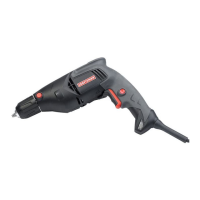
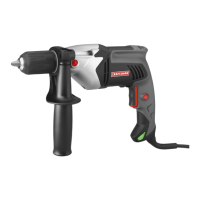
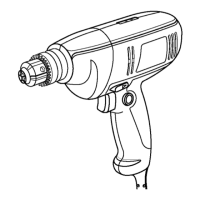


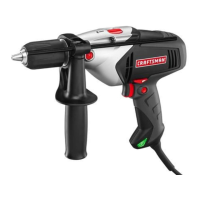




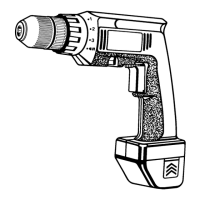

